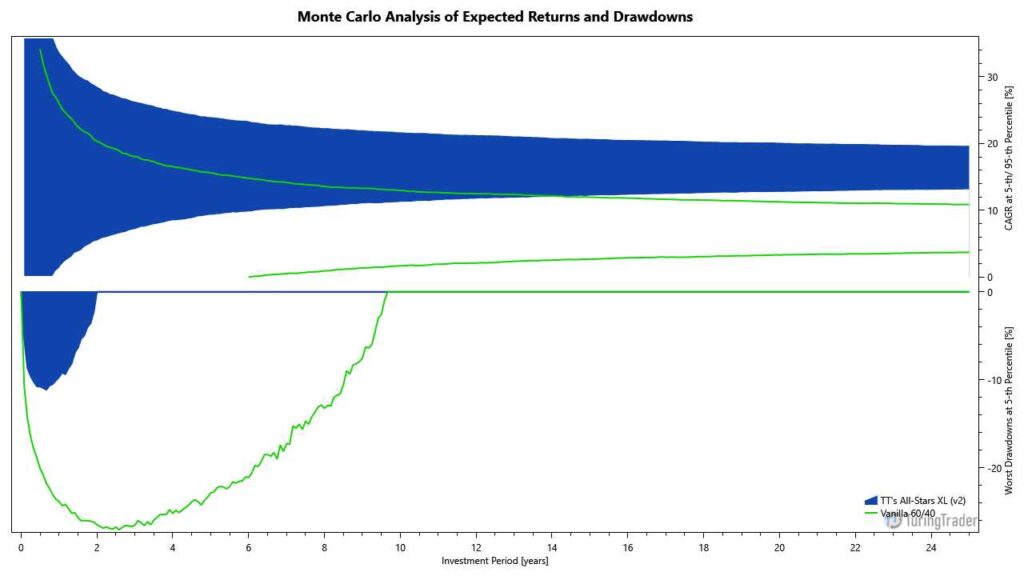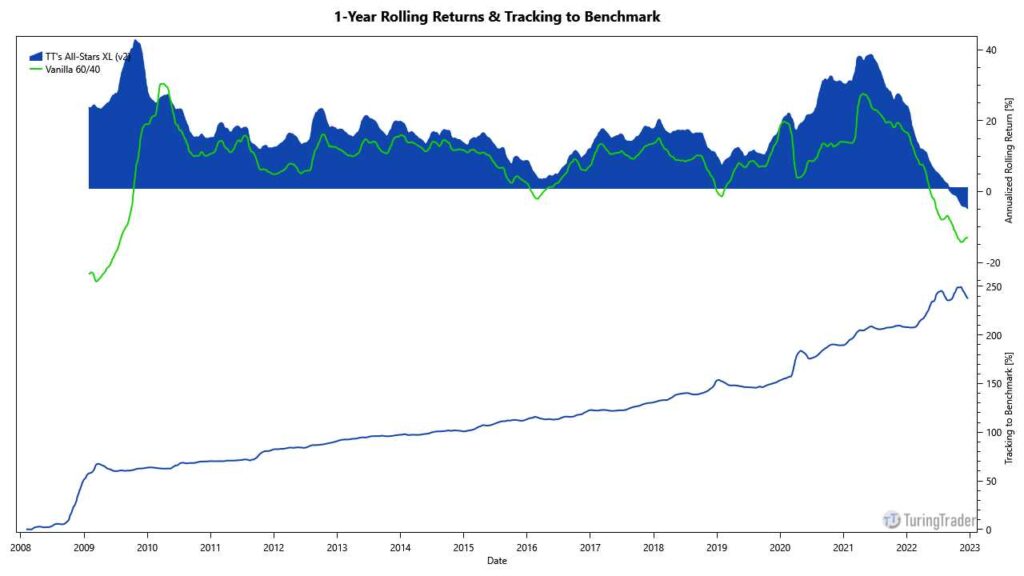Summary
- Objective: balanced growth
- Type: momentum strategy
- Invests in: ETFs tracking equities, fixed income, hard assets
- Rebalancing schedule: monthly
- Taxation: 90% short-term capital gains
- Minimum account size: $3,000
Brian Livingston is a successful dot-com entrepreneur and an investigative journalist. Livingston published the Mama Bear strategy in the book Muscular Portfolios, which he released in 2018.
Livingston’s Mama Bear aims to achieve stock-like returns, while requiring only little maintenance and avoiding deep drawdowns. Mama Bear achieves its objective through a momentum-based selection of three ETFs from a menu of nine, covering all major asset classes.
The portfolio requires only little maintenance: rebalancing is scheduled once per month.
Performance
This table shows the portfolio’s key performance metrics over the course of the simulation:
The following chart shows the portfolio’s historical performance and drawdowns, compared to their benchmark, throughout the simulation:
This chart shows the portfolio’s annual returns:
The following charts show the Monte-Carlo simulation of returns and drawdowns, the portfolios 12-months rolling returns, and how the portfolio is tracking to its benchmark:


Asset Allocation
The portfolio last required rebalancing after the exchanges closed on @last-rebal@. Due to fluctuations in asset prices, the exact allocations vary daily, even when no rebalancing occurred. The current asset allocation is as follows:
Sign up for our FREE Basic membership to see the asset allocation.
Sign up for our FREE 14-day trial to see the asset allocation.
Strategy Rules
The operation of Mama Bear can be summarized as follows:
- trade a universe of nine ETFs covering U.S. and international equities, U.S. fixed-income, and hard assets
- rebalance monthly
- rank all assets by their 5-months simple momentum
- allocate equal capital to the top-3 assets
Like most momentum strategies, an essential part of Mama Bear‘s returns stems from losing less than passive portfolios during recessions. Therefore, investors should always contemplate performance over the full economic cycle.
The book recommends skipping the monthly rebalancing unless an ETF is more than 20% off target. We feel that this exception makes it harder to communicate the target allocation to our readers. Consequently, we decided to rebalance our version of the portfolio every month. In our testing, this change made only very little difference to the overall results.
Diversification
While Livingston’s Mama Bear portfolio menu is diversified over three major asset classes, actual holdings might not be: the simple method of picking the three top-ranking ETFs can lead to being fully invested in just a single asset class. This shortcoming, combined with the delayed reaction of monthly rebalancing, leads to Mama Bear taking higher losses than a passive 60/40 when bullish markets suddenly turn sour.
Returns & Volatility
The portfolio managed the 2008 recession exceptionally well, with only about 17% drawdown, and without missing out on 2009’s rebound.
Our Monte-Carlo simulation paints a slightly different picture though: the confidence in the simulated low drawdown is very low, and Mama Bear‘s overall risk profile is slightly taller than that of a vanilla 60/40. Nonetheless, risk-adjusted returns show that the strategy’s excess returns justify the added risk.
Account & Tax Considerations
When the strategy changes its selection of top-ranking ETFs, it triggers taxable events. The chart shows that Livingston’s strategy rarely holds any assets long enough to qualify for long-term treatment of capital gains. Instead, the strategy most often closes its positions after 3-months or less. Consequently, Mama Bear works best in tax-deferred accounts.
With the strategy only holding three ETFs at a time, it should work well in accounts with $3,000 or more.
